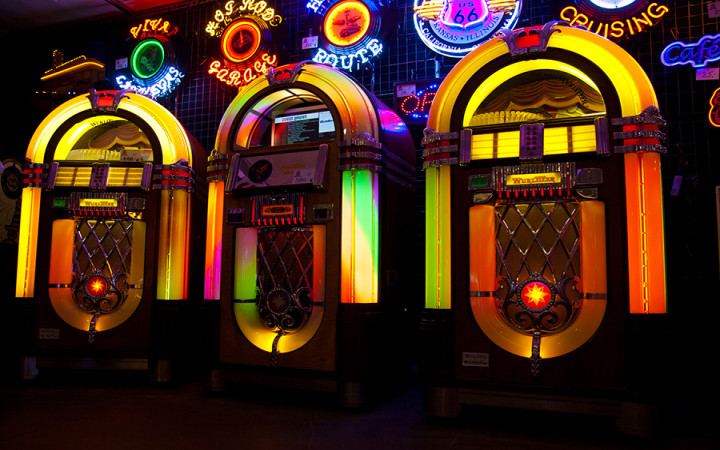Today’s Wonder of the Day was inspired by Easton. Easton Wonders, “How do records work?” Thanks for WONDERing with us, Easton!
We were just about to have lunch at the Wonderopolis diner the other day when we heard a racket over by the jukebox. A small group of farm animals was arguing over what song to play:
Chicken: I want to hear The Chicken Dance!
Dog: No one in the diner wants to dance. Why don't we play B-I-N-G-O?
Cow: We already know your name, Bingo. Let's just listen to Old MacDonald Had a Farm. That way we can all sing along!
Sure enough, the cow dropped a quarter into the jukebox and Old MacDonald Had a Farm was soon blasting through the speakers. With a cluck-cluck here, a bark-bark there, and a moo-moo everywhere, the animals soon had the entire diner singing along.
This musical lunch experience got us to thinking about the jukebox. Who invented that marvelous contraption and how long has it been around?
The first jukebox in history looked nothing like the jukeboxes we're familiar with today. On November 23, 1889, inventor Louis Glass installed a music machine in a corner of the Palais Royale Saloon in San Francisco.
The machine was an Edison phonograph modified with a coin slot and installed inside an oak cabinet. A 25-pound sulfuric acid battery provided electricity to run the phonograph. It could only play one wax cylinder at a time, which had to be changed by hand.
Since amplification hadn't been developed yet, users had to listen to the music through one of four listening tubes. The tubes looked a bit like stethoscopes that went into people's ears. Handkerchiefs hung on the side of the machine, so people could wipe off the tubes after each use.
It cost a nickel for each tube per song. Glass referred to his machine as a "nickel-in-the-slot" phonograph. This name eventually evolved into nickelodeon, which was a popular nickname for early jukeboxes.
As technology advanced, so did the jukebox. In 1906, John Gabel's "Automatic Entertainer" could play 24 different selections on 10-inch discs.
In the 1940s, three manufacturers competed to build the best jukebox in the world: Wurlitzer, Seeburg, and Rock-ola. After RCA Victor introduced the smaller 45-RPM record in 1949, jukeboxes could soon offer more selections than ever. For example, Seeburg's "Select-O-Matic" jukebox offered 100 selections.
The jukebox arguably reached the height of its popularity in the 1950s. Experts estimate there were as many as 750,000 jukeboxes across the U.S. at that time.
Over time, records gave way to compact discs (CDs). Today, modern jukeboxes simply play digital music files. This allows today's jukeboxes to offer thousands of selections.
Rock-ola is the last jukebox factory in the U.S. The company still supplies all the machines for Johnny Rockets, a 1950s themed restaurant chain. Some experts believe there are still as many as 250,000 jukeboxes across the U.S.




